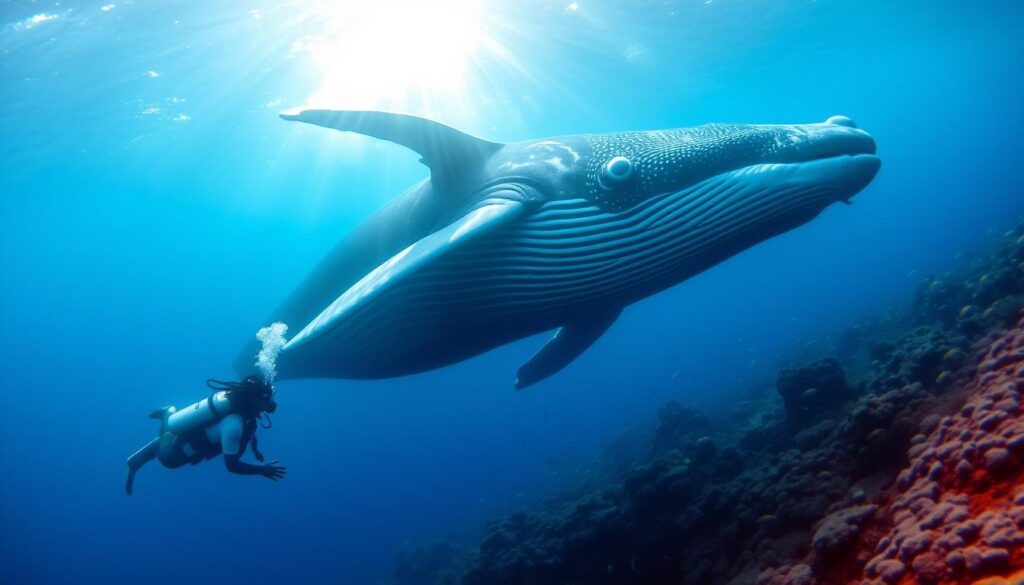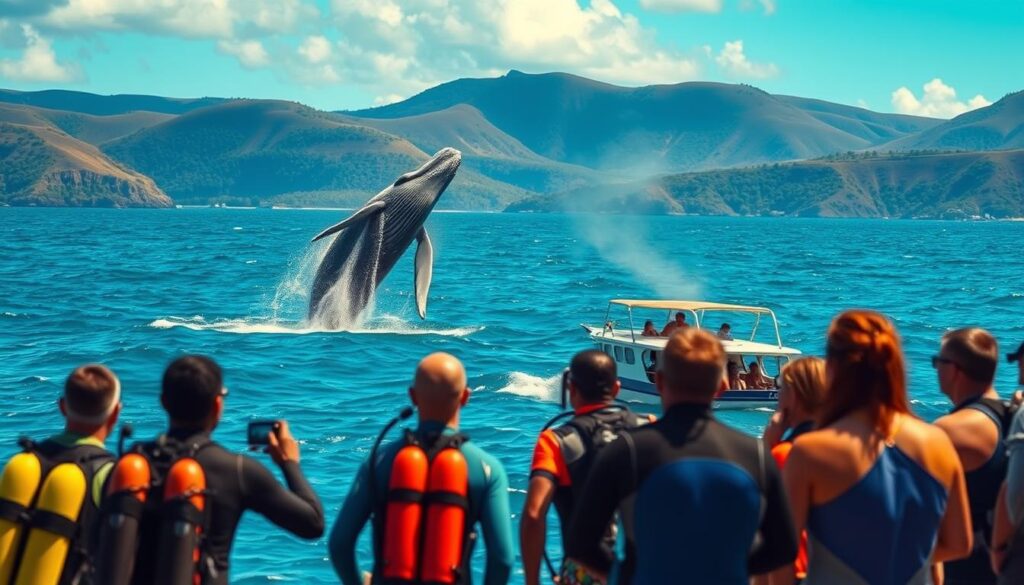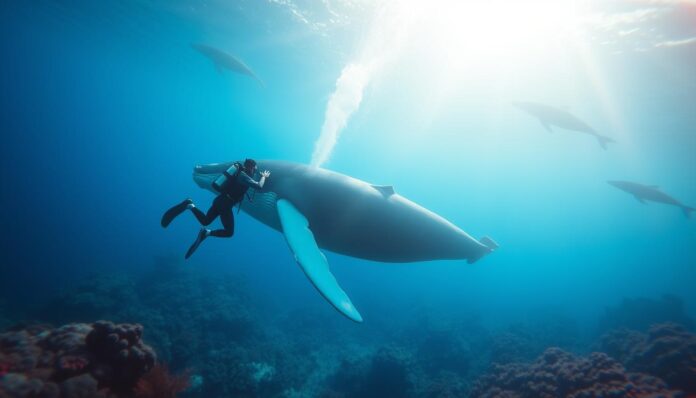Did you know a blue whale’s heart is as big as a small car? It can weigh up to 1,000 pounds. This amazing fact introduces us to the world of scuba diving with whales. It’s an adventure that changes how we see the ocean.
Scuba diving with whales is more than a fun activity. It’s a deep connection with incredible creatures. These dives let us see marine life in its true home, making unforgettable memories.
Exploring the ocean with whales is not just about seeing them. It’s about learning their world and respecting their home. Each dive is a chance to see these gentle giants in their natural place.
Key Takeaways – Diving with Whales
- Whale diving offers an unparalleled underwater adventure
- Unique opportunities to observe marine life up close
- Critical importance of responsible diving practices
- Potential for transformative personal experiences
- Contributing to marine conservation awareness
Introduction to Scuba Diving with Whales
Whale watching becomes an amazing experience when you dive into the water. Diving tours let you see these huge creatures up close. It’s a chance to make memories that will last forever.
Scuba diving with whales is a special journey. It’s different from other sea experiences. You get to connect closely with the ocean’s smartest and most beautiful creatures.
What Makes Scuba Diving with Whales Unique?
The magic of whale encounters is their surprise and beauty. Studies from Tonga and Fiji show how whales behave:
- Whales often swim circles around divers
- They might breach or slap their tails
- Every meeting is a special, personal moment
The Appeal of Underwater Encounters
Swimming with these gentle giants feels deeply connected to marine life. People often feel thrilled and thankful after diving with whales.
“To dive with a whale is to understand the true majesty of our ocean’s most magnificent creatures.”
Safety Considerations
Professional diving tours focus on safety for both people and whales. Important rules include:
- Keep a safe distance
- Listen to the guide’s instructions
- Use PADI safety training
- Know how to read whale signals
Companies like Kaimana Divers keep groups small. They offer personal lessons for a safe and unforgettable experience.
Understanding Whale Species
Ocean exploration opens up a world of amazing whale species. These marine mammals are some of the most incredible creatures on Earth. Knowing about their unique traits helps divers see the complexity of underwater life.
Whales are divided into two main groups. They differ a lot in their biology and how they eat:
Common Species Encountered While Diving
- Humpback Whales: Known for spectacular breaching behaviors
- Blue Whales: The largest animals on Earth
- Sperm Whales: Featuring the largest brain of any animal
- Orcas: Intelligent predators with complex social structures
Differences Between Baleen and Toothed Whales
| Characteristic | Baleen Whales | Toothed Whales |
|---|---|---|
| Feeding Method | Filter feeding through baleen plates | Active hunting with teeth |
| Brain Size | Smaller | Larger, more complex |
| Communication | Lower complexity | Advanced vocalization and echolocation |
Seasonal Migration Patterns
Whale migrations are incredible journeys. Gray whales migrate about 8,000 kilometers each year from Alaska to Mexico. They show amazing navigation skills during these ocean explorations.
“Whales are not just animals; they are living monuments to the incredible diversity of our planet’s marine ecosystems.” – Marine Biologist
Learning about these amazing creatures deepens our respect for the underwater world. It turns marine life encounters into unforgettable moments.
Top Destinations for Whale Diving
Exploring the world’s most incredible whale diving spots is a dream for many. Diving tours and whale safaris let you see these amazing creatures up close. They are in their natural home.
The planet has many amazing places for snorkeling with whales. Each spot offers its own special marine experiences:
- Silver Bank, Dominican Republic: It’s where the world’s largest gathering of North Atlantic humpback whales happens. About 3,000 whales come here to mate and give birth from January to April.
- French Polynesia: It’s known for its incredible diving. You’ll see a variety of marine life and beautiful underwater scenes.
- Sea of Cortez, Mexico: Here, you can swim with whale sharks. It’s a great place to see the marine diversity.
Ideal Diving Seasons
When you plan your whale diving trip, timing is everything. Different places have the best times for whale sightings:
| Location | Best Months | Whale Species |
|---|---|---|
| Baja California, Mexico | December – April | Gray and Humpback Whales |
| Iceland | May – August | Humpback, Blue, and Minke Whales |
| Tonga | July – October | Humpback Whales |
Local Regulations and Guidelines
Responsible whale diving means following strict rules. These rules help protect whales:
- Keep at least 650 feet (200 meters) away from whales
- Don’t have too many people around whales
- Always follow local marine conservation rules
“Whale diving is not just an adventure, it’s a privilege to witness these magnificent creatures in their natural environment.”
Every place for whale diving offers a special experience. It’s a chance for unforgettable memories for those who love the sea and want to help protect it.
Preparing for Your Whale Diving Adventure
Going on underwater adventures with whales needs careful planning and the right mindset. Scuba diving with whales is a unique experience that requires thoughtful preparation and specific skills.
Essential Gear for Successful Diving
Choosing the right equipment is key for a great whale diving experience. Here are the must-haves:
- High-quality wetsuit (2-3mm for temperate waters, 7-8mm for cold regions)
- Mask with excellent visibility
- Fins designed for open water
- Underwater camera for capturing memories
- Safety signaling devices
Physical Fitness and Training Requirements
Whale diving is more than just excitement. You should:
- Be comfortable swimming at least 200 meters unaided
- Maintain good cardiovascular fitness
- Practice breath control and relaxation techniques
- Take swimming lessons if needed
Tips for First-Time Divers
For those new to whale diving, here are some important tips:
- Start with guided tours from experienced operators
- Learn basic marine interaction protocols
- Manage expectations and stay calm
- Respect whale habitats and maintain recommended distances
“The ocean is a magical world waiting to be explored, one whale encounter at a time.”
Scuba diving with whales is a privilege that needs preparation, respect, and wonder. Your marine world journey starts with understanding and preparation.
The Best Scuba Diving Practices
Exploring the underwater world is a mix of adventure and respect for marine life. Eco-tourism has changed how we dive with whales. Now, we focus on practices that protect these amazing creatures.
Conservation Tips for Whale Encounters
Understanding whale behavior is key to marine conservation. The Oceanic Society, with 55 years of experience, offers important guidelines:
- Maintain a minimum safe distance from whales
- Move slowly and predictably underwater
- Avoid sudden movements or loud noises
- Never attempt to touch or feed marine mammals
Maintaining a Safe Distance
Licensed whale swim operators have strict rules. These rules protect both divers and whales. They include:
| Distance Requirement | Diver Limit | Speed Restriction |
|---|---|---|
| 300 meters from whales | 4 guests per guide | No-wake speed near whales |
Techniques for Approaching Whales
Expert guides teach us how to interact with whales respectfully:
- Enter water quietly and calmly
- Approach from the side, never directly
- Remain calm and observe whale behavior
- Be prepared to retreat if whale shows discomfort
“Respect the ocean, and the ocean will reveal its wonders.”
By following these guidelines, divers can have amazing whale encounters. This supports the protection of these incredible marine ecosystems.
What to Expect During a Dive
Whale watching and marine life encounters offer an extraordinary underwater adventure. They change how you see the ocean. Diving with these magnificent creatures gives you a unique experience. It connects you with the marine world’s most impressive inhabitants.

When preparing for a whale diving expedition, understanding what awaits beneath the waves is key. Humpback whales, which can reach lengths over 50 feet and weigh up to 44 tons, create breathtaking moments during underwater encounters.
Typical Dive Conditions
Diving conditions vary depending on location, but expect the following characteristics:
- Water temperatures ranging from 70-80°F in prime whale watching areas
- Visibility typically between 30-100 feet
- Potential challenges include currents and depth variations
Whale Behavior to Observe
During your marine life encounter, you might witness remarkable whale behaviors:
- Breaching: Whales launching themselves out of water
- Tail slapping: Communication and stunning displays
- Singing: Intricate underwater communication
“Looking a humpback whale in the eye is a transformative experience that connects you directly with the ocean’s most majestic creatures.” – Marine Biologist
Personal Experiences
Divers often describe whale watching as a profound, emotional journey. The Silver Bank, a renowned whale sanctuary, hosts thousands of whales annually. Typical excursions include small groups of around seven participants, allowing for intimate marine life encounters that can last up to 15 exhilarating minutes.
Photography Tips for Whale Encounters
Underwater adventures give photographers a chance to capture the amazing world of the ocean. To take pictures of whales, you need special skills and gear. This helps you capture these incredible marine encounters.
Getting great whale photos takes technical skill and planning. Experts say using certain techniques can lead to stunning images.
Best Practices for Underwater Photography
- Use continuous shooting mode (4-6 frames per second)
- Select fast shutter speeds (1/1000th of a second)
- Maintain optimal aperture settings around f/8
- Adjust ISO based on light conditions (typically 400)
Capturing Whale Behavior
Knowing how whales behave is key for amazing underwater photos. Photographers should be ready for different marine interactions.
| Whale Behavior | Photographic Opportunity |
|---|---|
| Breaching | Dramatic aerial shots |
| Tail-slapping | Dynamic water interaction |
| Lunge feeding | Intense marine hunting scene |
Recommended Equipment
The right gear makes a big difference in ocean photography. Here are some must-haves:
- Telephoto zoom lens (100-400mm)
- External underwater viewfinder
- Waterproof camera housing
- Strobe lights for low-light conditions
“Patience and respect are a photographer’s greatest tools when capturing whale encounters.” – Marine Photography Expert
Remember that responsible photography helps protect marine wildlife for future underwater explorers.
The Role of Dive Guides
Diving tours with whales are an amazing adventure that needs expert guides. These guides are key to making your whale safari safe, educational, and unforgettable.
Choosing the right dive operator is very important. Not all guides are the same. Knowing their skills is essential for a great whale experience.
Selecting a Reputable Dive Operator
When planning diving tours, consider these key factors:
- Conservation track record
- Safety protocols
- Years of marine experience
- Local knowledge of whale migration patterns
Understanding Dive Instructors’ Expertise
Experienced dive instructors are vital for whale safari adventures. They know a lot about marine life and whale behavior. This knowledge keeps everyone safe and protects the environment.
“A great dive guide transforms an ordinary whale encounter into an extraordinary educational experience.” – Marine Biology Research Institute
Importance of Guided Tours
Guided whale diving tours offer safe and responsible ways to see marine life. They teach how to interact with whales properly. This helps protect both humans and whales.
In places like the Silver Bank, where only three vessels are allowed each year, guided tours are essential. They make sure whale encounters are sustainable and respectful.
The Conservation Impact of Whale Diving
Whale diving is a powerful mix of marine conservation and eco-tourism. It gives travelers a chance to help protect the ocean. As more people learn about it, it’s becoming key for saving marine life.

Eco-tourism is changing how we protect the sea. It helps local communities by making money from whale diving. This encourages them to keep the marine world safe.
Economic Value of Whale Conservation
The economic benefits of saving whales are huge. Studies show one whale adds about $2 million to the ocean’s health. With over 100 million whales, their total value is over $3 trillion.
| Conservation Metric | Impact |
|---|---|
| Whale Economic Contribution | $2 million per whale |
| Total Whale Economic Value | Over $3 trillion |
| Whale-Watching Tourism Revenue | $2 billion annually |
Respecting Marine Life
Responsible whale diving means following strict rules:
- Maintain safe distances from marine mammals
- Follow local regulatory restrictions
- Minimize underwater noise and disruption
- Support organizations dedicated to marine protection
“Every dive is an opportunity to become a steward of our ocean’s most magnificent creatures.”
Ongoing Protection Efforts
Groups like the World Cetacean Alliance are leading the way in protecting whales. They create marine sanctuaries, set strict rules for interacting with whales, and study whale populations.
By joining eco-tourism efforts, divers help protect the ocean. They ensure these amazing marine worlds are safe for future generations.
Stories from Experienced Divers
Underwater adventures with whales turn simple dives into unforgettable moments. Divers share amazing stories that show how whale watching changes lives. These tales highlight the deep connection we can make with marine life.
Memorable Encounters with Whales
Diving fans talk about moments that change their lives. One diver met a 15-meter humpback whale. This encounter was pure wonder.
“Meeting these magnificent creatures in their natural habitat is the ultimate wildlife experience,” shared marine wildlife expert Sarah Richards.
Lessons Learned Beneath the Waves
Underwater adventures teach us about marine life and conservation. Divers learn important rules for watching whales:
- Maintain a respectful distance of 100 meters from whales
- Observe without disturbing natural marine ecosystems
- Prioritize animal welfare over personal excitement
Sharing the Experience with Others
Experienced divers help protect marine life by sharing their stories. Their tales inspire others to care for marine life. They teach the importance of responsible whale watching.
| Dive Location | Whale Species | Key Observation |
|---|---|---|
| Mayotte | Humpback Whale | Maximum 2 boats allowed during observations |
| Georgia Aquarium | Whale Sharks | Two sharks measuring 23 and 27 feet |
Every dive is a chance to see marine life’s magic. It’s also a way to help global conservation efforts.
Conclusion: Embrace the Adventure
Scuba diving with whales is more than just a dive. It’s a journey into marine conservation. Divers feel a deep connection with the ocean’s creatures, making unforgettable memories and raising awareness.
To prepare for whale diving, you need to keep learning and diving responsibly. Improve your skills, stay calm, and learn about marine life. Every dive helps protect these amazing animals.
Continuing Your Ocean Learning
It’s important to know about marine life and whale protection. Join local groups, attend workshops, and help with research. These steps will help you understand whales better and support important causes.
Joining the Whale Enthuasiast Community
The world of whale diving is full of people who love the ocean. Connect with them online, in networks, and through diving groups. Share your experiences, learn new things, and help protect our oceans.
FAQ – Diving with Whales
Is scuba diving with whales safe for beginners?
Scuba diving with whales is exciting but not for everyone. You should have some diving experience. Most tours need you to have a basic PADI certification or similar. Make sure you’re comfortable in the water and talk to experienced guides.
What whale species can I expect to encounter while diving?
You might see humpback whales, sperm whales, orcas, and more. Places like French Polynesia and the Dominican Republic’s Silver Bank are great for spotting different whales during their migrations.
What equipment do I need for whale diving?
You’ll need a good wetsuit, mask, fins, and an underwater camera. Some tours offer special gear for whale watching. Your gear should fit well and let you move easily underwater.
How close can I get to whales during a dive?
You should stay at least 15-100 feet away from whales. This keeps them calm and safe. Always listen to your guide and follow local rules.
What is the best time of year for whale diving?
The best time for whale diving changes by location. For example, in Hawaii, you can see humpback whales from December to May. In the Caribbean, it’s usually January to April. Check the best times for your destination.
Do I need special photography equipment for whale encounters?
You don’t need a pro camera to take great whale photos. Waterproof digital cameras or GoPros work well. Think about the depth, light, and stabilization when choosing your camera.
How can I contribute to whale conservation during my dive?
Pick eco-friendly tours and dive responsibly. Keep a safe distance from whales and avoid touching marine life. Supporting conservation groups also helps protect whales and their homes.
What physical fitness level is required for whale diving?
You don’t need to be super fit, but you should be able to swim well. Some tours want you to have basic fitness and swim confidently in the sea.
Are there age restrictions for whale diving?
Most tours need you to be 12-16 years old, with a parent’s okay. For more challenging dives, you might need to be 18 or older.
How much does a whale diving experience cost?
Prices vary a lot, from $500 to $5,000. Costs depend on where you go, how long you stay, and what’s included in the tour. Different places and times affect the price too.
